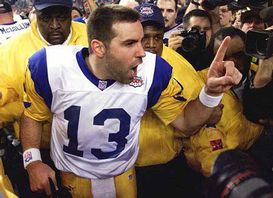The declining significance of June 1
June 1 used to mark the beginning of the final wave of free agency. Teams would primarily release players due to excessive contracts or declining performance because the proration from the remaining years of a contract doesn’t accelerate until the following year when a player is released after June 1. Only the current year’s proration counts towards the cap after June 1.
Over 20 players were released after June 1 in some years, with some big name players hitting the open market. Jerry Rice and Kurt Warner were June 1 salary cap casualties. June 1 free agents were at a disadvantage in the market place because most teams had already filled their needs through the NFL draft and cap space was at a premium. As a result, most players couldn’t get deals that would have reflected their market value if they had been released at an earlier date.
 Former Rams quarterback Kurt Warner is one of the more significant June 1 salary cap casualties.
Former Rams quarterback Kurt Warner is one of the more significant June 1 salary cap casualties.
June 1’s impact changed in 2006 when the collective bargaining agreement included a new provision that allowed teams to release two players each year prior to June 2 that were treated under the cap as if they were released after June 1. The player’s entire cap charge had to remain on the team’s cap until June 2 in order for the player to be given post-June 1 treatment. This provision remains in effect under the current collective bargaining agreement.
There are other factors that have contributed to June 1’s decreased importance. Generally, teams have become better with cap planning, particularly with the collective bargaining agreement allowing teams to carry over unused cap room from one year to the next. Teams are better able to absorb large amounts of bonus proration accelerating into the cap than in the past. For example, the Jacksonville Jaguars cut Laurent Robinson one year after signing him to a five-year, $32.5 million contract. His 2013 cap charge increased from $6.3 million to $8.4 million by releasing him in March.
Agents started negotiating player friendly contracts when they had leverage with more frequency. With roster bonuses and contract guarantees that vest before the start of or shortly after free agency begins more prevalent in contracts, teams have been required to make roster decisions on players much earlier. If a team decides against paying the roster bonus or guaranteeing salary, the player becomes a free agent in February or March when teams have cap space and money to spend. The Arizona Cardinals released Kevin Kolb before his $2 million fifth day of the league year (March 16) roster bonus was payable. He signed a two-year, $6.1 million deal (worth up to $12.6 million with incentives and escalators). Some of the players with these clauses would be released after June 1 if their contracts were structured differently.
Teams also were starting to become more judicious with June 1 free agents even before they were given two post-June 1 designations annually. A majority of the time their acquisitions didn’t have the impact that was anticipated.
Eleven players, detailed in the chart below, were given post-June 1 designations this year.

Every player except Jared Gaither has signed a contract with a new team. Most of the players quickly signed contracts after being released.
Ryan Fitzpatrick probably has benefitted the most from receiving a post-June 1 designation. He signed a two-year, $6.5 million contract (worth a maximum of $9.7 million through incentives), including $3.25 million fully guaranteed, with the Tennessee Titans a couple weeks after being released by the Bills. If Fitzpatrick had to wait until after June 1 to become a free agent, it would have been difficult for him to sign a contract that paid him towards the top of the backup quarterback market. His best situation could have been signing a modest one-year deal with the New York Jets to replace David Garrard, who recently retired because of injuries, under this scenario.
Michael Huff provides the biggest cap relief among the post-June 1 designees, with the Oakland Raiders gaining $8 million in cap room. The cap space will be welcomed by the Raiders because they are currently at their cap limit. $6.4 million of the cap room will be used by Oakland to sign their 10 draft picks.
The Miami Dolphins are the only team to use both of their post-June 1 designations. Karlos Dansby and Kevin Burnett’s salaries coming off the books will increase Miami’s cap room from $7.25 million to $17.94 million, which gives the Dolphins’ the seventh largest amount of cap room in the NFL.
Doug Free and DeAngelo Williams were prime candidates to be released after June 1 before they reworked their contracts. Free took a pay cut from $7 million to $3.5 million. He also lowered his 2014 base salary to $3.5 million from $8 million, with his salary becoming fully guaranteed on the fifth day of the 2014 league year (March 15). Williams kept his 2013 salary at $5 million but created $3.2 million of cap room by converting $4 million of his salary into a signing bonus and adding two voidable contract years for cap purposes. A $4 million pay cut in 2014 was also a part of his contract restructuring.
June 1 once had special significance to the National Football League but has largely become just another day on the NFL calendar in recent years.
Follow me on Twitter: @corryjoel
Joel Corry is a former sports agent who helped found Premier Sports & Entertainment, a sports management firm that represents professional athletes and coaches. Prior to his tenure at Premier, Joel worked for Management Plus Enterprises, which represented Shaquille O'Neal, Hakeem Olajuwon and Ronnie Lott. You can email Joel at jccorry@gmail.com